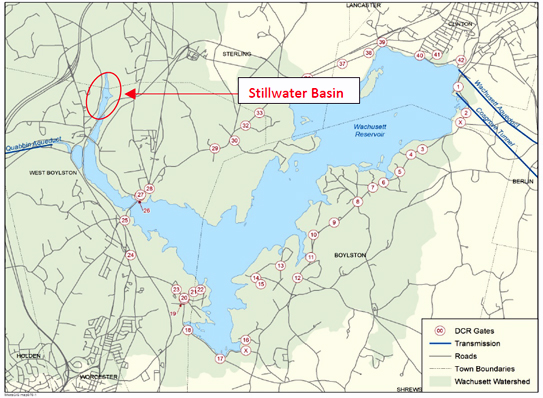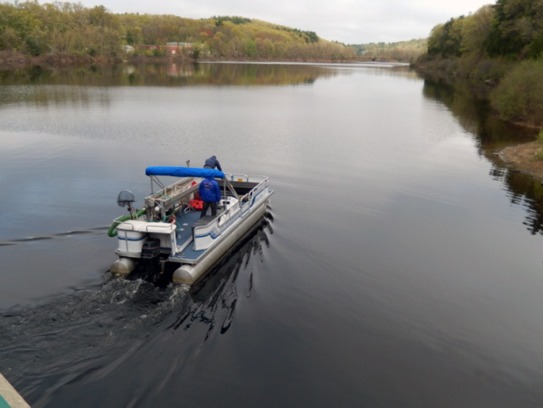FOR IMMEDIATE RELEASE
Leonard Cawley, Community Relations Manager
(617) 660-7972,leonard.cawley@mwra.com
MWRA to Begin Large-Scale Removal of Invasive Aquatic Plants
from Wachusett Reservoir
|
|||||||||||||
Background: The Stillwater River supplies the Wachusett Reservoir via a series of basins (Stillwater, Oakdale and Thomas). The invasive plants Eurasian watermilfoil (Myriophyllum spicatum – Figure 1) and Fanwort (Cabomba caroliniana) were discovered in 2001 in Stillwater Basin, the uppermost basin (Figure 2). Both plants are known to aggressively displace native vegetation and grow into nuisance densities. These plants propagate through seeding, roots and by fragments of stems which drift downstream, sink and form new plants. Because of the large areas of shallows in the Wachusett Reservoir, particularly in the North Basin near the Intake, there is great concern over invasive plants colonizing these areas. Invasive plants can quickly reach nuisance densities and create impairments to water quality.
After the discovery of these plants, a study was performed to assess options for eradication. One probable solution was to dredge the basin. However, since this method was quite costly, environmentally disruptive, and required a lengthy permitting process, MWRA decided not to delay addressing the problem and began, in 2002, control efforts such as placing benthic barriers to smother the plants, seasonal hand-pulling by divers, and installation of floating fragment curtains. These combined efforts prevented the migration of these plants into the main basin of the reservoir. Success was measured by no pioneering invasive plants observed in the main body of the reservoir during seasonal surveys, and the program continued annually. Recent Developments:
2013 Invasives Control: Schedule: MWRA contractors will deploy three DASH boats utilizing six divers starting May 15, 2013. They will work the Stillwater Basin following a grid pattern starting at the northern end of the basin and move south. The project will occur in two phases from May 15th to October 15th to cull the initial growth and return later in the season to address likely regrowth. MWRA will also deploy a Quality Assurance Diver to inspect and videotape the underwater work zones for documentation MWRA’s goal is to remove the source invasive plants from Stillwater Basin to protect the Wachusett Reservoir’s water quality. Detailed follow-up monitoring and selected diver hand-pulling in subsequent seasons after this project will be required to ensure the plants do not return. MWRA is also developing long-term alternatives, such as dredging, if the DASH approach does not achieve the desired level of control.### |
Posted May 13, 2013



